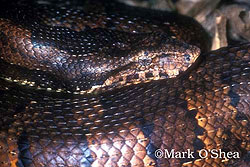Check out the New Guinea ground boa.

Mark O' Shea
The most common snake inhabiting coconut husk piles on Karkar Island is the New Guinea ground boa.
Distribution: Eastern Indonesia, Papua New Guinea and Bismarck Archipelago.
Habitat: Coconut plantations and rainforests.
Diet: Lizards, small mammals and frogs.
Max.length: 0.8-0.9m SVL (0.9-1.0m TL).
Reproductive strategy: Viviparous with 17-20 neonates.
The most common snake inhabiting coconut husk piles on Karkar Island is the New Guinea ground boa, a sedentary, stout-bodied snake, which is called ‘sleepy snake’ in PNG and ‘viper boa’ in the reptile trade. This is the westernmost and probably the most advanced of the of the Pacific boas which evolved in Samoa-Fiji region and radiated westwards as far as the Moluccan islands of eastern Indonesia. Although inoffensive and inclined to adopt a ‘balling’ position when disturbed, the occasional large ground boa will strike and deliver a painful bite. It was easy to differentiate between males and females on Karkar Island because females lack cloacal spurs although this characteristic is not necessarily uniform across the range of the species.
Taxonomic note: Two subspecies may be recognized as follows.
Bismarck ground boa (C.aspera aspera) from New Britain and New Ireland, and New Guinea ground boa (C.aspera schmidti) from New Guinea (West Papua and Papua New Guinea) and its continental islands including Karkar. The scale counts defining the two subspecies are listed in the table below.
In addition, a single New Ireland juvenile compared with several juvenile Karkar Island specimens, was found to be of more slender build, have a longer tail, a raised vertebral ridge and lighter coloured eyes but all those characters are relative and the sample was small.
Sources for more information:
Bustard H.R. 1969 Defensive behavior and locomotion of the Pacific boa Candoia aspera, with a brief review of head concealment in snakes. Herpetologica 25(3):164-170.
Harlow P. & R.Shine 1992 Food habits and reproductive biology of the Pacific island boas (Candoia). Journal of Herpetology 26(1):60-66.
Johnson C.R. 1975 Thermoregulation in the Papuan-New Guinean boid and colubrid snakes, Candoia carinata, Candoia aspera and Boiga irregularis. Zoological Journal of Linnean Society. 56:283-290.
Loveridge A. 1948 New Guinean reptiles and amphibians in the Museum of Comparative Zoology and United States National Museum. Bulletin of the Museum of Comparative Zoology, Harvard. 101(2):307-430.
McDowell S.B. 1979 A catalogue of the snakes of New Guinea and the Solomons, with special reference to those in the Bernice P.Bishop Museum. Part III. Boinae and Acrochordidae. Journal of Herpetology 13(1):1-92.
O’Shea M. 1989 The boas of the southwest Pacific. The Herptile. 14(1):20-30.
1994 The herpetofauna of coconut husk piles on Kar Kar Island, Madang Province, Papua New Guinea: The initial surveys. ASRA Journal 1994:51-72.
1996 A Guide to the Snakes of Papua New Guinea. Independent Pub. xii+239.
Stickel W.H. & L.F.Stickel 1946 Sexual dimorphism in the pelvic spurs of Enygrus. Copeia 1946(1):10-12.
Stull O.G. 1932 Five new subspecies of the family Boidae. Occasional Papers of the Boston Society of Natural History. 8:25-30.

